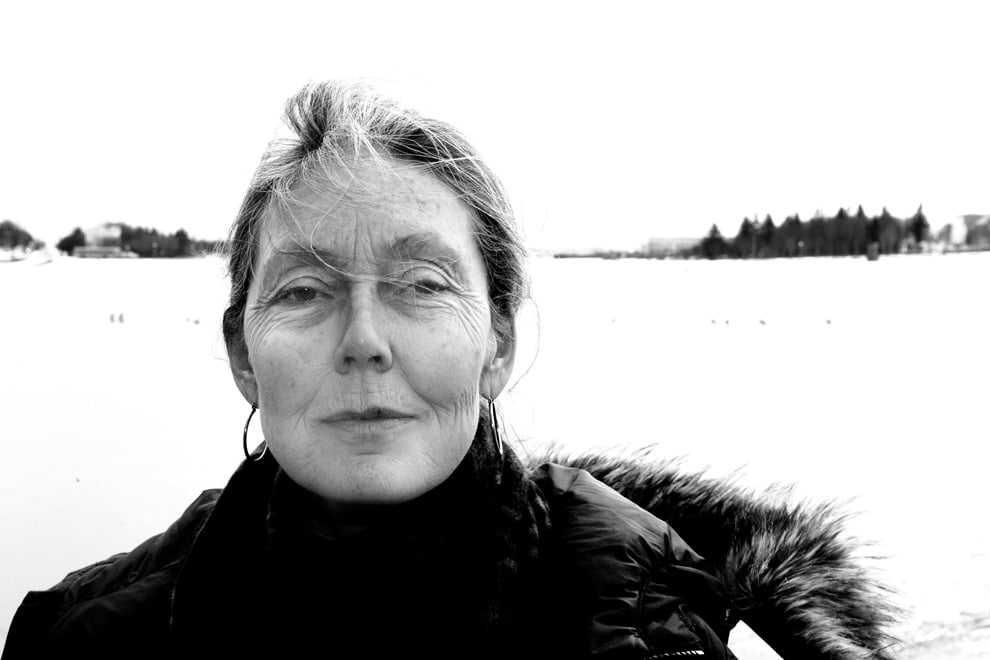Anne Carson, author of approximately sixteen books of poetry, essays, and translation (the precise number depends on how you count her several collaborations), is to a certain segment of the population a major celebrity. Originally from Canada, Carson has lived for many years in Ann Arbor, Michigan, where she teaches classics and comparative literature at the university. Her erudite, unconventional, yet highly relatable brand of writing has won her a Guggenheim fellowship and a MacArthur Genius grant, among other prestigious prizes.
Carson’s books are notable both for their originality and their relative (sometimes paradoxical) approachability. Carson draws on her classics background to blend contemporary narratives with ancient myths, or to radically modernize ancient Greek writers by translating them without regard for anachronism (a character in her translation of Sophocles’ Antigone has a powerboat, for example). She has been praised for her deft, deeply informed, often humorous characterizations of desire and unrequited love. And as she breaks the rules of chronology, she also breaks the rules of genre, writing poetry that resembles prose, essays that resemble poetry, and operettas that resemble short plays by Samuel Beckett.
Her fans (I count myself among them) are generally people with degrees in English literature, and, perhaps not coincidentally, they are numerous. Although Carson’s works have much to recommend them intrinsically, I suspect part of the reason many fans remain so devoted to Carson’s books is imprinting. They met the right book at the right age, and the habit stuck. The prototypical story of falling in love with Anne Carson’s books goes something like this (I speculate, but not without experience):
An undergraduate on a break from a tumultuous, age-typical relationship pauses to browse the remainder bin at a bookstore. (Carson is one of the very few poets whose books are published in large enough print runs to end up in remainder bins.) S/he finds a copy of Autobiography of Red or Plainwater and takes it home, reading the whole thing in a night or two. This is not especially unusual. Said undergraduate has done more or less the same thing with Gabriel Garcia Marquez, Virginia Woolf, and (failing miserably) James Joyce. But due in part to the fact that Carson is still publishing prolifically, whereas the other writers are mostly either dead or slowing down, Carson’s books gradually begin to take over the reading list. The fact that her books are strangely accessible and speak to the precise feelings of monstrosity and loneliness an undergraduate relationship can induce only helps.
By the time Carson publishes a book that is not really a book but a hefty box filled with a very long accordion-folded sheet of paper (See description of NOX, below), she is claiming more home bookshelf space than any other poet, living or deceased. She is also claiming more space than most novelists who aren’t David Foster Wallace, Proust, or Robert Ludlum, and among these three, Carson enjoys the distinction of having her books read all the way through, sometimes repeatedly. The undergrad is by this time long out of school, but this is beside the point. Carson, more than high modernism, cafeteria food, or even tumultuous relationships, is a lifelong pursuit.
Of course, many people were not swept up in this phenomenon. They were older when Anne Carson’s books came out, or they majored in economics or biology or a different subspecialty of English lit. They browsed the wrong remainder bins, or they were in the sort of tumultuous undergraduate relationship in which their partner stormed off with the Anne Carson books before they could read any.
Maybe they even picked up a book once, but were put off either by the title (e.g. Decreation), the subtitle (e.g. Poetry, Essays, Opera), or the cover image (e.g. a translucent X-ray style image of a child’s frilly onesie, standing ominously without a child in it). In all likelihood, they put the book straight down. Perhaps this experience made them feel inadequate in some way, although it’s also possible that, being self-assured types, they were completely unperturbed. They did not become fans of Anne Carson. Today, these people constitute the majority of the population. Maybe you are among them. This isn’t necessarily shameful.
Step 1: Address your fears
If you do decide to read Anne Carson, it’s important to start with the right book. Which book this is will depend, in part, on whether there is anything you are particularly afraid of. Maybe the phrase “contemporary poetry” sends chills down your spine, and not in the positive sense. In this case, you may be comforted to know that many people don’t believe that what Anne Carson writes is really poetry at all. These skeptics include the critic John D’Agata, who asked of Carson’s work “how prosaic, rhetorical, or argumentative can a poem be before it becomes something else altogether, before it reverts to prose, to essay?” Even her publishers have hedged their bets, subtitling books with ambiguous phrases like “A Novel in Verse.” But if you are reluctant to read even prose-like poetry, maybe you should start with Carson’s translations, which include several plays.
Another fear some people have is not understanding what’s going on. In order to appreciate Anne Carson, you will almost certainly have to get over this. While her books contain readily identifiable, mostly straightforward narratives, the joy of reading them often comes from well-timed moments of total absurdity. For example, her most recent book, Red Doc>, contains an extended lyrical description of the grazing habits of a herd of muskoxen. Just at the point when our attention begins to flag, one of the oxen “spins up off its shanks and performs a 360-degree spin in air and returns to place,” and, without missing a beat, Carson resumes her straightforward description.
In any case, the notion that delight is connected primarily with understanding things is not necessarily true at all. One need only watch a cat video such as this one to know otherwise.
Step 2: Let the right one in
There are many ways of selecting a book. The random-purchase method, the see-what-the-library-has method, and the seize-your-friend’s-possessions method are all time-honoured, statistically-proven ways of beginning to read Anne Carson.
But if you desire a more systematic approach, refer to this list. (You may find it helpful to imagine yourself as a fish. Or, if this possibility disturbs you, don’t.)
Book: Short Talks (1992)
Hook: Some fathers hate to read but love to take the family on trips. Some children hate trips but love to read. Funny how often these find themselves passengers in the same automobile.
How it will consume you: Microlectures on a variety of topics (for example, Sylvia Plath, housing, why some people find trains exciting, defloration, and the sensation of airplane take-off). The tone is pleasantly instructional without ever lapsing into anything quite so boring as logic. The talks are as accessible as an audio tour of a museum, and about twelve times as entertaining.
Book: Plainwater: Essays and Poetry (1995)
Hook: I was a young, strong, stingy person of no particular gender—all traits advantageous to the pilgrim.
How it will consume you: A compilation of poetry and prose, including a loveable series of poems about towns (“September Town,” “Pushkin Town,” and “Town of the Little Mouthful” among them), and a wry, luminous essay on the pilgrimage to Santiago de Compostela in Spain.
Book: Autobiography of Red (1998)
Hook: Although a monster Geryon could be charming in company.
How it will consume you: The oddly familiar, strangely relatable coming-of-age story of a mythical monster-boy named Geryon, who gets his heart broken in the same way we all do—by having sex with Hercules, who dumps him and murders his cattle.
Book: Men in the Off Hours (2001)
Hook: Your nose is wrong. / Your feet are wrong. / Your eyes are wrong your mouth is wrong. / Your pimp is wrong even his name is wrong.
How it will consume you: A heavily referential collection of poetry based on the works of Edward Hopper, Catullus, Anna Akhmatova, St. Augustine, Hokusai, Virginia Woolf, and many others. Luckily it’s hilarious.
Book: Decreation (2005)
Hook: What are you doing? / Calling the police. / Why? / To give them a description of your gun. / How do you describe it? / Thin, dark, rather nervous, almost birdlike. / You have entirely misunderstood my gun.
How it will consume you: Like Men in the Off Hours but with more genres. I recommend “Lots of Guns: An Oratorio for Five Voices” as the perfect dinner party singalong, especially if you have friends or relatives with differing views on the issue of gun control.
Book: NOX (2010)
Hook: My brother ran away in 1978, rather than go to jail. He wandered in Europe and India, seeking something, and sent us postcards or a Christmas gift, no return address. He was travelling on a false passport and living under other people’s names.
How it will consume you: A book in a box, which looks as though it could hold stationery, old letters, or an ample quantity of school supplies. Contained is a lyrical meditation on the death of the author’s brother, printed on a single, very long, accordion-folded sheet of paper, and illustrated with photographs.
Book: Red Doc> (2013)
Hook: You could take the entirety of the common sense of humans and put it in the palm of your hand and still have room for your dick. [Emphasis original]
How it will consume you: A sequel to Autobiography of Red, featuring the self-same winged monster-boy, all grown up and travelling to glaciers, volcanoes, cow pastures, psychiatric wards, and his mother’s deathbed.
*Note that a number of books are missing from this list, including Eros the Bittersweet: An Essay; Glass, Irony and God; Economy of the Unlost; The Beauty of the Husband; Grief Lessons: Four Plays by Euripides; An Oresteia; Antigonick; and If Not, Winter. This is a concession to time and space, rather than the expression of any sort of grudge. In order to read them, you will have to rely on one of the other methods.
Step 3: Watch for the signs
Before beginning a hike, it’s usually best to have some landmarks in mind. That way you will know where to eat lunch, where to pee, and where to appreciate the beauty. So it is with reading Anne Carson.
Here is one thing to watch for. Carson, a hiker after my own heart, relies greatly on the unexpected pause. This is to say that she interrupts the natural rhythm of sentences in order to create emotional tension or another effect—perhaps a pee break. Most poets do this, but Carson does it especially, using line breaks and ungrammatical periods the way some people eat chocolate chips at switchbacks.
This short poem from Plainwater is a good example of Carson’s pauses at work:
Town of my Farewell to You
Look what a thousand blue thousand white.
Thousand blue thousand white thousand.
Blue thousand white thousand blue thousand.
White thousand blue wind today and two arms.
Blowing down the road. (p. 111)
Although it contains very few words, none of them the obvious choices, it manages to convey a clear picture of ocean waves breaking and a person trying to swim, perhaps against them, perhaps unsuccessfully. The end stops are the troughs between waves, also known as the space in which a person lurches between unexpressed emotions.
Perhaps not unrelated to Carson’s ability to convey ideas using very few words are her excellent characterizations of animals. Always look for the animals in Carson’s books. They are some of the most reliable animals you will meet. Even if you do not identify with any of the human characters, you will surely identify with the cows, bats, and trout.
Here is one of Carson’s dogs:
Are there many little boys who think they are a
Monster? But in my case I am right said Geryon to the
Dog they were sitting on the bluffs The dog regarded him
Joyfully (Autobiography of Red, p. 12)
But maybe the most important thing to watch for while reading Anne Carson is evidence that the “latches of being” are coming undone. “Latches of being” is a phrase Carson coins to describe the work of another poet, the ancient Greek writer Stesichoros. Of him, she writes, “Stesichoros began to undo the latches… All the substances in the world went floating up. Suddenly there was nothing to interfere with horses being hollow hooved. Or a river being root silver. Or a child bruiseless.”
Of course Carson is concerned with exactly the same task in her own work—that of freeing language from its usual habits in order to express things more directly. In Short Talks, her first collection of poetry, she asserts, “Soon I hope to live in a totally rubber house. Think how quickly I will be able to get from room to room! One good bounce and you’re there.” Keep an eye out for these bounces. They happen as quickly, oddly, and profoundly as muskoxen change direction in mid-air.






